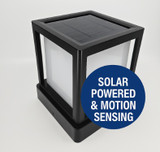Photopic vs. Scotopic Lumens: Why These Lumens Matter for LED Lights
LED lighting systems have gained popularity due to their efficiency and technologically advanced features. Business owners and managers of commercial properties who understand photopic and scotopic lumens and why these lumens matter for LED lights can make more informed lighting decisions. In this article, we'll delve into what these terms mean and why they matter for LED lights.
Understanding Photopic Lumens
Photopic lumens, also known as "daylight vision,” represent the light emitted by lighting systems under brightly lit conditions. This type of light is detected by the cone cells in our eyes, which are responsible for color vision and visual acuity.
For commercial spaces, such as offices and retail stores, photopic lumens play a crucial role in providing visibility and creating the illusion of daylight. The higher the photopic lumens, the brighter the lighting solution appears, leading to better visibility and an overall more comfortable environment.
Grasping Scotopic Lumens
On the other hand, scotopic lumens or "night vision" represent the light detected by our rod cells during low-light conditions. Unlike cone cells, rod cells are responsible for detecting brightness and contrast but aren't capable of distinguishing colors.
In commercial settings, scotopic lumens become vital when assessing the effectiveness of outdoor lighting, parking lots, and security systems. These areas often rely on proper visibility in dim or dark environments to ensure safety and functionality.
Why These Lumens Matter for LED Lights
LED lighting solutions, known for their energy efficiency and long-lasting performance, are particularly suited for businesses and commercial properties. They allow for customization of both photopic and scotopic lumens, enabling precise optimization in various applications based on the needs of the users.
By understanding the difference between photopic and scotopic lumens, decision-makers can select LED lights that comprehensively suit their environments. For instance, in a commercial workspace, prioritizing high photopic lumens would create a bright atmosphere, promoting productivity and comfort. Conversely, in areas with low-light conditions like parking lots or storage facilities, LED lights with higher scotopic lumens will create better visibility, adding an extra layer of safety and security.
Selecting the Right LED Solution
Choosing the right LED lighting system requires an understanding of how photopic and scotopic lumens impact human perception and visibility. By identifying a commercial property's specific requirements, businesses can select an optimized LED solution that provides an energy-efficient, long-lasting, and customized lighting experience.
When making the switch to LED or upgrading existing systems, it's essential to consult with a lighting expert to ensure proper implementation and maximize the benefits that LED technology offers. By doing so, you’ll create a brighter, more comfortable, and more energy-efficient environment for your business and its occupants.
Don't leave your commercial spaces in the dark. Illuminate your business areas with Induction Lighting Fixtures' advanced LED solutions. We specifically design our LED parking garage lights for optimal visibility and safety. Choose our LED systems and experience the difference in energy efficiency, durability, and quality of light. Let Induction Lighting Fixtures guide you in creating safer, brighter, and more sustainable environments. Contact us today to learn more and light up your world with our state-of-the-art LED solutions.
Recent Posts
-
How Long Will Solar Powered Lighting Operate in the Rain?
How Solar Light Fixtures Can Run for 10 Rainy Days If you’ve ever wondered how a Commercial solar li …Jul 30th 2025 -
Spotlight - The IL-SPG54 Smart Solar Walkway Light: Where Performance Meets Simplicity
Introducing the IL-SPG54 Smart Solar Walkway Light: Where Performance Meets Simplicity When it comes …Jun 16th 2025 -
Corn Bulb Sale - While supplies last!
⚡ Limited Time Sale – BLE Series Corn Lamps Starting at $24.99! Stock up now while supplies last – p …Jun 11th 2025






